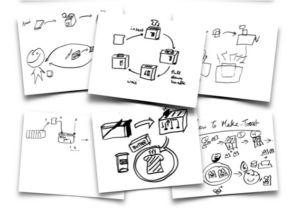The “Draw Toast” Creativity Exercise: A Recipe for Better Brainstorming & Innovation

What is the “Toast” Exercise
As a team we’re always looking for interesting and effective warm-ups to start our ideation sessions with clients. We wanted to share one of our all-time favorites with you. We call it the “toast” exercise or “draw toast” but a more accurate label would be the “draw how to make toast” exercise. It’s creator, Tom Wujec, envisioned it as way to get participants started down the path of ‘systems thinking.’ It certainly can do that, but we have found it’s a fantastic way to get a group engaged and ready to start any type of ideation work.
The instructions for this low-key design exercise are deceptively simple…
Draw a picture of how to make toast. That is, darkened crispy bread. Use no words in your diagram. Try to illustrate the important actions to someone who has never made toast before.
How You Facilitate the “Toast” Exercise
Materials: All you need for this exercise are paper and markers, or any other drawing tools. You can also use digital devices but these actually add friction in the process and prioritize the medium over the message.
Task Briefing: The facilitator presents the task: “Draw toast.” No words allowed. How would one show this process to someone? If the audience needs a nudge, reinforce that this is not about who is the best illustrator. An effective diagram is likely to be one that clearly demonstrate the STEPS involved in the process.
Work Individually: Give participants a specific amount of time to create their drawings. We generally keep this to roughly 5 minutes. Some will be ‘done’ with time to spare and others will be begging for more time to finish their ‘masterpiece.’
Sharing, Discussion & Reflection: After the drawing phase, each participant presents their creation to the group. This is an opportunity for individuals to explain their unique interpretations of the task. Encourage a brief group discussion about what the participants learned from the exercise.
Why We Like the “Toast” Exercise
Genuinely Interesting: As the group shares their drawings you’ll definitely notice differences. How do these observations potentially inform the work the group is about to do?
- Some drawings are simple others complex. Is there a right level of complexity?
- People are present in some and absent in others. Why? What role do people play?
- There are different starting points e.g. the cabinet to get the bread vs. the store to buy the bread vs. the farm to grow the wheat to make the bread. What is the right way to frame or bound the exercise?
- The toaster itself is sometimes featured more than the broader process. Again, what is the right way to bound the exercise?
- Some drawings may have no toaster at all! Many Europeans make toast with a frying pan. Do differences in point-of-view and context matter?
Mood Booster & Energy Lifter: This exercise is legit fun! Some participants are proud of their drawings others can laugh at themselves and their attempt that may not be hall-of-fame material. It never fails to set the right tone for the day.
Open & Inclusive: It doesn’t require any specific expertise or prior training. It’s accessible to individuals from various backgrounds and skill levels, making it a valuable icebreaker or warm-up exercise for diverse groups.
Visual Thinking: It encourages visual thinking, which can be a powerful way to communicate ideas. It reminds participants they can use images and symbols to convey complex concepts, a skill that can be applied in various problem-solving scenarios.
Team Building: The sharing and discussion phase of the exercise fosters a sense of camaraderie. It allows participants to appreciate the diverse perspectives and variety of assumptions present within the group and helps build a collaborative atmosphere for follow-on work.
The “Draw Toast” creativity exercise has been a favorite of ours for years and always generates a positive response from clients and meeting participants. It’s a valuable tool for any group looking for new ways to kickstart their ideation sessions. You can find additional information here.
Share this blog post:
